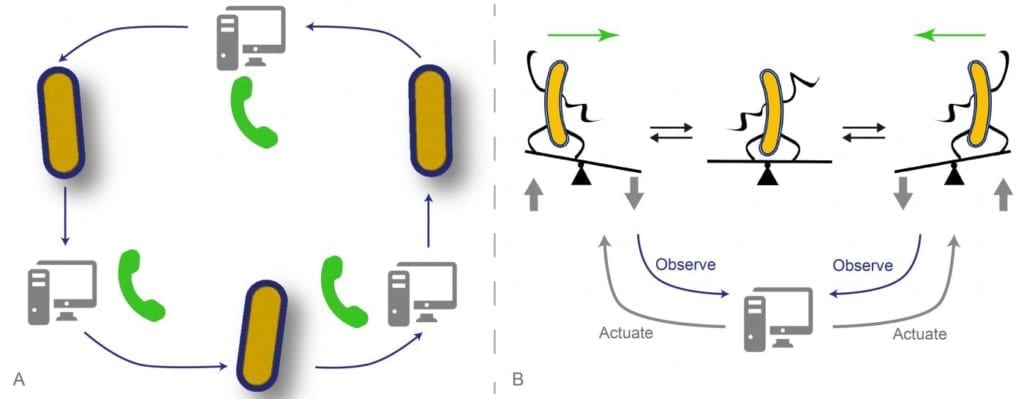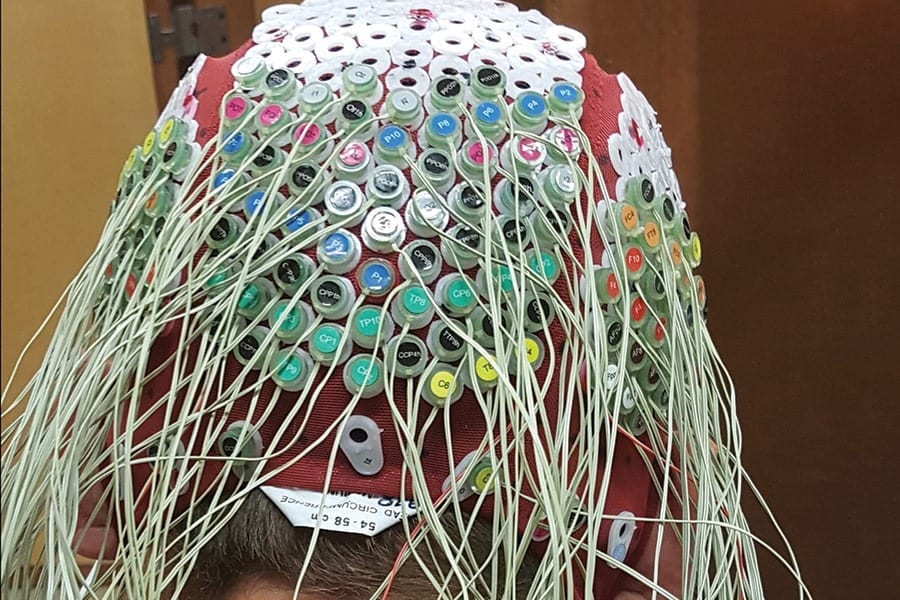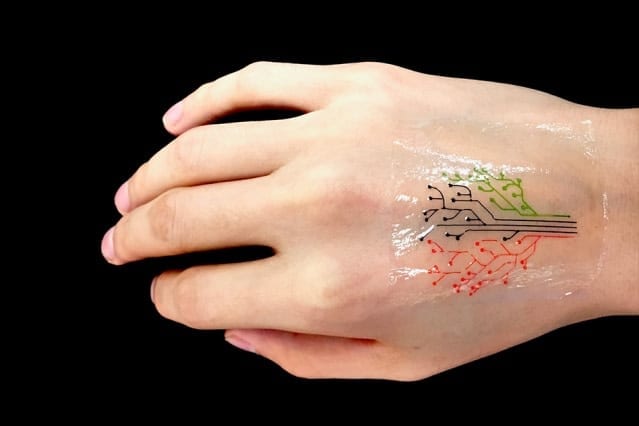
Researchers from the Pasteur Institute and Inria, with researchers from the CNRS and Paris Diderot University, and from the Institute of Science and Technology (IST) in Austria, have published two articles in Nature Communications about computer control of cellular processes. Hybrid experimental platforms combining microscopes and software are enabling researchers to interface living cells with control algorithms in real time. The two articles illustrate that these solutions make it possible to create new and easily reprogrammable behaviours of cell populations. This external control of living tissue would then become a formidable research tool for acquiring a detailed understanding of the biological role of certain proteins and for optimising bio-production processes.
The goal of synthetic biology, which combines biology with engineering, is to (re)program cells in order to improve their performance in a specific task, or so that they can efficiently perform a new task. One of the challenges in this discipline is thus to bypass the limitations of existing biological systems. For example, it is hard to obtain the same gene expression in different cells, even if they are grown in the same medium. Thanks to these cutting-edge technologies, the researchers are able to provide homogeneous control of a cellular process over a very long period.
Researchers from the Pasteur Institute andInria, the CNRS andParis Diderot University, and the IST Austria have developed two platforms connecting a microscope to a computer. The cells are placed in a microfluidic device in which the chemical environment can be varied or the cells can be exposed to light stimulations. A computer program decides which modifications are to be made in the chemical or light environment according to the cells’ observed behaviour and the objective of the experiment. The computer also manages the acquisition of images by the microscope and their analysis, to quantify the cellular responses in real-time.
In the first article, the researchers from the InBio – Experimental and computational methods for modelling cellular processes unit (Pasteur Institute / Inria)[1] and from two groups at IST Austria, the Systems and Synthetic Biology of Genetic Networks group, headed by C?lin C. Guet, and the Biophysics and Neuroscience group, headed by Gašper Tka?ik, have used optogenetics to activate the expression of a gene by exposing cells to light. A fluorescent protein is used to measure the amount of produced protein. A controller, using a model of the system, can then in real-time decide which dynamic disturbances to apply based on the expected future behaviour of the cells. Thanks to the computer programs created by the researchers, they can control each cell individually in various ways, or create virtual communication between several cells, which circulate messages in an easily reconfigurable order. “We have managed to build a platform allowing us to design circuits that are partially biological and partially virtual. The virtual parts of these circuits can be arbitrarily modified to quickly create and explore cellular behaviors, even beyond what is biologically possible” explains Jakob Ruess, co-first author of the first article.
In the second article , Grégory Batt, head of the InBio unit and co-last author with Pascal Hersen (CNRS) of the Laboratoire Matière et systèmes complexes (CNRS/ Paris Diderot University, explains how they managed to place a cellular system in an unstable configuration: “We designed a computer program which aims to force the cells to take binary decisions randomly. To do this, the cells are driven to a region of instability – like climbers on a mountain ridge line – and they are then left to evolve freely towards one of the two possible stable configurations. Unexpectedly, we observed that a given stimulation, if correctly chosen, was capable of taking groups of different cells to the region of instability and keeping them there. These results could help gaining a clearer understanding of how cell populations collectively take robust decisions without individual coordination”.
Learn more: COMPUTERISED BIOLOGY, OR HOW TO CONTROL A POPULATION OF CELLS WITH A COMPUTER
The Latest on: Computerised biology
[google_news title=”” keyword=”computerised biology” num_posts=”10″ blurb_length=”0″ show_thumb=”left”]- Disillusionment plagues young Latinos who could decide the 2024 race in battleground stateson April 27, 2024 at 3:01 am
NBC News spoke to young Latino students in Arizona, Pennsylvania and Georgia, states where their voting bloc could sway the 2024 presidential election.
- Lab mice might be doing their own experimentson April 26, 2024 at 8:00 am
New research suggests that mice base their decisions on more than just immediate reward. They may also make 'mistakes' on purpose.
- Why IBM’s dazzling Watson supercomputer was a lousy tutoron April 26, 2024 at 2:00 am
With a new race underway to create the next teaching chatbot, IBM’s abandoned 5-year education push offers lessons about AI’s limits.
- Biologists Construct Groundbreaking Tree of Life Using 1.8 Billion Letters of Genetic Codeon April 25, 2024 at 6:32 pm
Scientists have constructed a groundbreaking tree of life using 1.8 billion letters of genetic code. A recent study published in the journal Nature by an international team of 279 scientists, ...
- Cabrini teacher made science fun for 45 yearson April 25, 2024 at 11:30 am
Ann Smart, a beloved science teacher of 45 years and the 'bedrock' of Cabrini High School's faculty, will retire at the end of the school year.
- Imitation game: Can AI rival student intellect?on April 24, 2024 at 7:41 pm
Can machines think? Proposed by British computer scientist Alan Turing, it is arguably the most famous opening line of an academic paper and a question that continues to be debated 70 years after it ...
- Colorado enacts groundbreaking brain data privacy lawon April 24, 2024 at 6:15 pm
Colorado became the first state in the nation to enact a law protecting neural data, emphasizing the growing intersection of technology and human biology while ensuring privacy in the expanding field ...
- AI smartphones may soon help monitor chronic wounds from homeon April 24, 2024 at 5:00 pm
Wenyao Xu, professor and associate chair in the Department of Computer Science and Engineering ... associate professor in the Department of Oral Biology; and Heamchand Subryan, MFA, director of ...
- Researchers map the spatio-temporal human brain dynamics of a visual image being recognizedon April 24, 2024 at 7:21 am
For nearly a decade, a team of MIT Computer Science and Artificial Intelligence Laboratory (CSAIL) researchers have been seeking to uncover why certain images persist in people's minds, while many ...
- Computer model suggests frozen cells could be used to save northern white rhino from extinctionon April 17, 2024 at 7:39 am
A team of geneticists and computer scientists from the San Diego Zoo Wildlife Alliance, Cornell University and the University of California, Santa Cruz, has created a computer model that shows it ...
via Google News and Bing News










